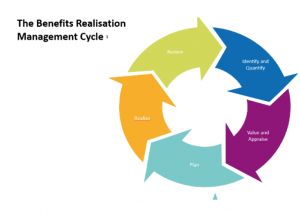To complement our series of QuickReads covering measurement, we will now explore Failure Demand (FD).…

Quick Glance Case Study: Establishing a Benefits-Driven Approach to Change
“Process mapping techniques allowed us to identify significant gaps in the benefits scoping and tracking process”
After completing a ChangeWise Lean Practitioner training course one candidate submitted the following work-place project to gain their qualification to LCS Level 1c.
The Business Challenge
The client had a vast number of change programmes and initiatives in their pipeline. With the current challenging economic climate, value for money and return on investment had become more important than ever. However, the client historically delivered project outputs focusing on delivery according to time, cost and scope – very little emphasis had been placed on actual benefits realised, or the tracking of benefits.
This created a series of issues, including lack of benefits realisation, double counting of benefits, and no opportunity for future improvements through lessons learned. Without the means of planning, tracking, realising and reviewing the benefits process, the client would continue to risk investing in expensive change initiatives without fully understanding how the investment would benefit the strategic objectives of the business.
![]()
Key people involved from client site
The team consisted of the changeportfolio team, with key inputs from stakeholders in the business stream and enabling functions.
Lean Methodology Employed
DMAIC (Define, Measure, Analise, Improve, Control)
Focusing on Customer CTQ’s (Critical to Quality) requirements, the candidate completed a full Lean review of the end-to-end current state data in scope. Using the DMAIC process, various Lean methodologies were employed including; Voice of Customer, SIPOC, Value Stream Mapping, Value and Non-Value Add Analysis, 7 Wastes and 7 Service Wastes, FMEA, and specifically root cause analysis.
Key Current State Findings

No consistent approach to benefits assessment.
Risk of initiative leads over-stating expected benefits as no standard approach to costing benefits and no agreed set of benefits criteria.
As a consequence, in later stages of the project lifecycle the investment group were informed that the change initiative is unlikely to deliver the benefits stated in the original request for funding.
Following the current state process mapping, our candidate held a workshop to understand the root cause for lack of benefits realisation and capture. This included interviews with SME’s across the business, and workshops members of the SLT to define a consistent benefits-driven approach to how future investment decisions could be made.
Benefits and Outcomes
Following the workshop, a steering group was established with the following objectives:
- To create and maintain an optimum portfolio of programmes and projects
- To increase the ROI of programmes and projects
- To progress towards a more benefits-focussed culture

The methodology and framework adopted conforms with industry best practice Benefits Realisation Management.
In Summary
This Lean assessment enabled our client to achieve greater use of benefits dependency mapping, create clearer and more comprehensive business cases, allow for more effective sanctioning of new programmes, increase their use of portfolio assessment matrices, and use more effective monitoring of benefits against benefit realisation plans to ensure they increase their bottom line whilst exceeding customer needs.
Interested in learning how you might enable more effective monitoring and realisation of benefits? Contact us at info@changewise.co.uk
ChangeWise believes employee engagement is the foundation for successful Change. Training and coaching your people to use simple continuous improvement techniques will enable your organisation to continuously adapt and stay ahead in a constantly changing and challenging environment.
For updates and interesting Lean Change insights, connect with us on LinkedIn.
Find out more about our Public Training Courses



